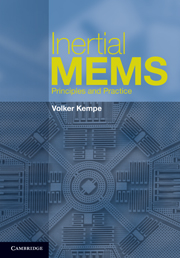9 - Test and calibration
Published online by Cambridge University Press: 03 May 2011
Summary
Testing of inertial MEMS includes
device characterization tests
product qualification tests
fabrication tests
product tests
in-field tests especially self-tests.
Characterization tests
Characterization tests are aimed at investigating the performance limits of a device under development. The knowledge of their dependency on fabrication tolerances, environmental conditions, and lifetime is necessary in order to determine pass–fail criteria for production and qualification. They include, for instance, performance characterization over temperature and temperature cycling, determination of shock robustness, especially the impact of different types of vibration, Q-bias tests for gyroscopes for various fabrication parameter settings etc.
Qualification tests
Qualification tests are the basis of qualification procedures for different stages of the fabrication process (wafer production and packaging) and for the final product and product components. Process qualification procedures end with a qualified production process.
Product qualification tests are product-specific and are performed in accordance with standard requirements for a given application area of the product. On the basis of representative test ensembles they should guarantee that a given product or product component fabricated on a given fabrication line and tested in accordance with a given test sequence will function in the field under the specified environmental conditions over the specified lifetime with a failure rate less than a requested limit.
- Type
- Chapter
- Information
- Inertial MEMSPrinciples and Practice, pp. 460 - 465Publisher: Cambridge University PressPrint publication year: 2011



